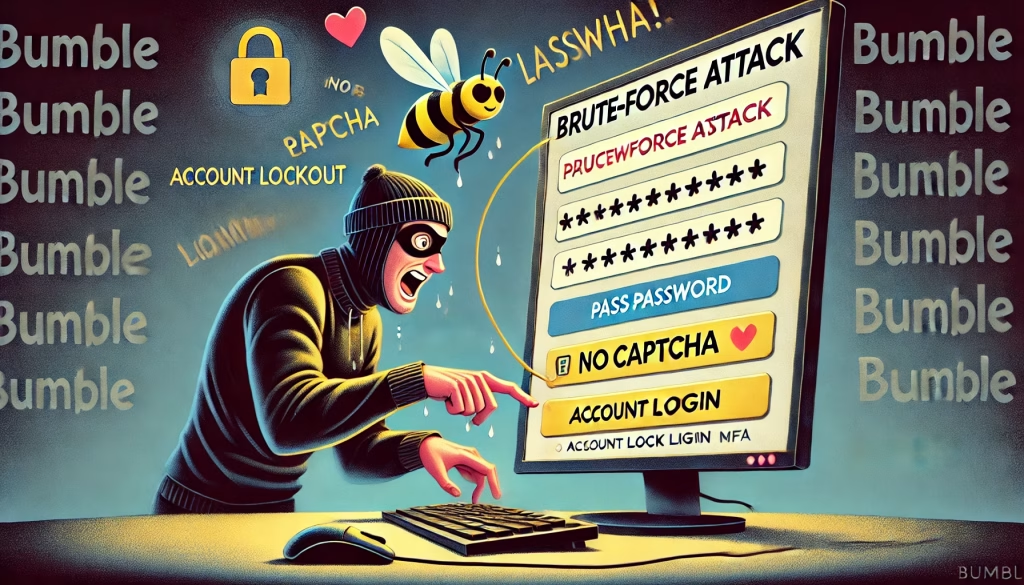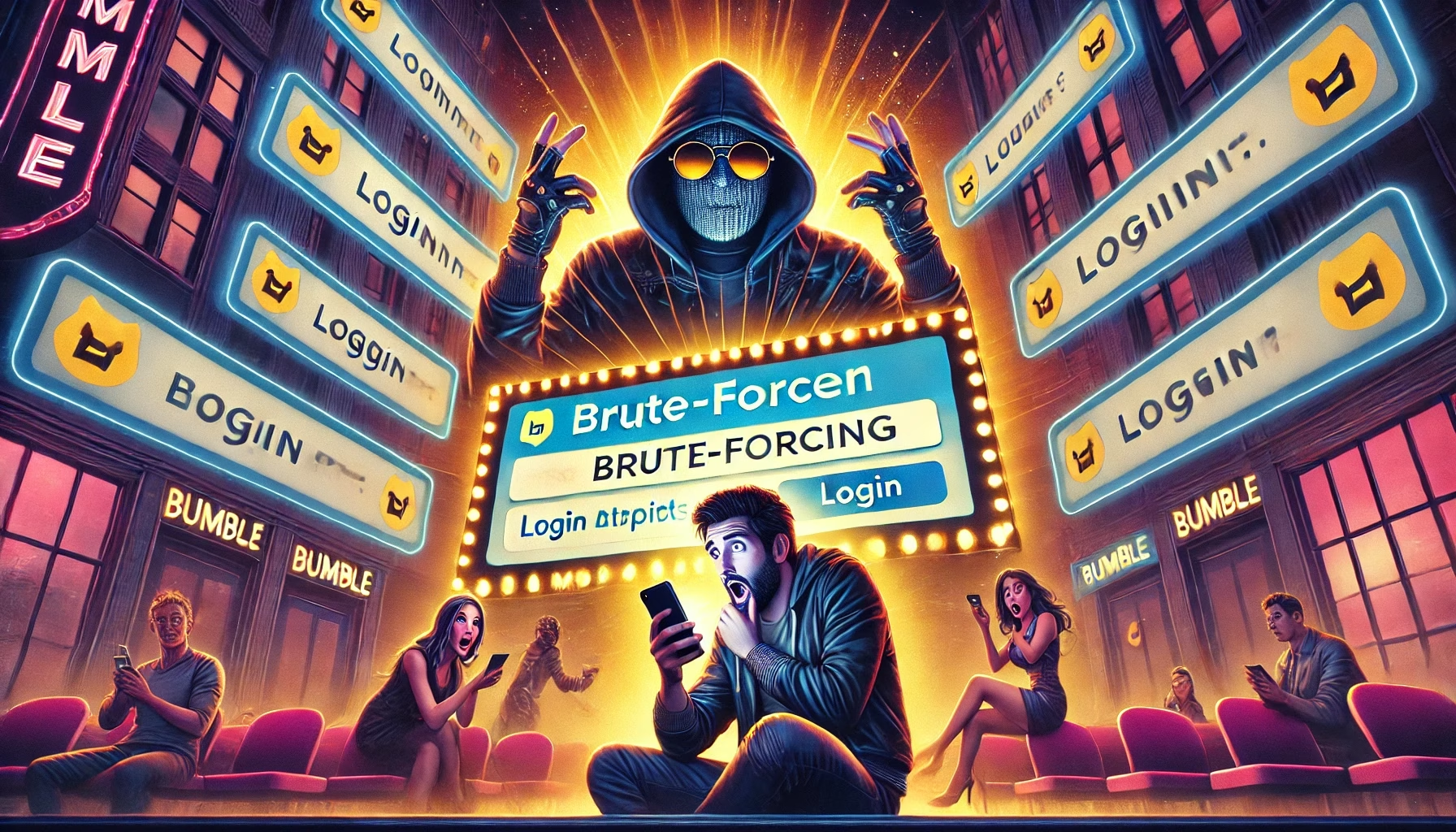Hello there! Your guy Zokomon is back with another cybersecurity deep dive. Today, we’re breaking down a Brute-Force Attack on Bumble 500$ Bug that was discovered in the login system of Bumble—a popular social platform. If you think your password is enough to keep your account safe, think again! Let’s dive into what happened, how hackers could exploit it, and what we can learn from this case. 🚀
What Was the Vulnerability? 🛑
A brute-force attack is when hackers try every possible password combination until they get the right one. Bumble’s login system failed to prevent repeated login attempts, making it an easy target.
Why Was This a Big Deal?
Bumble didn’t have basic security measures in place, meaning: ✅ No Account Lockout – Hackers could keep guessing passwords without any limits. ✅ No CAPTCHA – No protection against automated bots trying millions of passwords. ✅ No Multi-Factor Authentication (MFA) – A single stolen password was enough to take over accounts.

This made it incredibly easy for attackers to break into user accounts just by trying common or leaked passwords. 😨
How the Attack Worked 🎯
Want to know how hackers could have exploited this vulnerability? Here’s a step-by-step breakdown:
1️⃣ Go to the Login Page – Visit https://bumble.com/signin. 2️⃣ Use a Brute-Force Tool – Tools like Burp Suite’s Intruder can automate password attempts. 3️⃣ Guess Until You Succeed – Since there were no restrictions, attackers could keep trying passwords until they got the right one. 4️⃣ Gain Full Access – Once the correct password was found, boom! The account was compromised. 🔓
What Could Hackers Do With This? 😱
If a hacker cracked your password on Bumble, they could:
- Take over your account – Changing details, posting messages, or impersonating you.
- Steal personal data – Access private messages, photos, and sensitive info.
- Use it for phishing – Trick your friends into clicking malicious links.
- Try the same password elsewhere – Many people reuse passwords, making other accounts vulnerable too.

The impact? Massive privacy risks and potential identity theft. 🔥
How Bumble Fixed It 🛡️
Thankfully, once the vulnerability was reported, Bumble took action and added several security features:
✅ Rate Limiting – Limits login attempts per IP to prevent automated attacks. ✅ CAPTCHA – Verifies users after multiple failed attempts. ✅ Account Lockout – Temporarily locks accounts after repeated failed logins. ✅ Encouraging Multi-Factor Authentication (MFA) – Adds an extra security layer.
These steps drastically reduce the risk of brute-force attacks and make user accounts much safer. 👏
Key Takeaways: How to Protect Your Accounts 🔐
You might not be on Bumble, but these lessons apply to all online accounts. Here’s what you can do:
🔹 Use Strong, Unique Passwords – Avoid using the same password across multiple sites. 🔹 Enable Multi-Factor Authentication (MFA) – This makes it much harder for hackers to get in. 🔹 Use a Password Manager – To store and generate strong passwords. 🔹 Check If Your Email is in a Data Breach – Use haveibeenpwned.com to see if your credentials have been leaked.

Final Thoughts 🎤
This case is a wake-up call for websites that still don’t take login security seriously. If a popular platform like Bumble had such a basic vulnerability, imagine how many other sites might still be exposed. Cybersecurity isn’t optional—it’s a necessity! 🔥
Want to read the full vulnerability report? Check it out here: HackerOne Report #744692.
That’s it for today! What do you think about this case? Have you ever encountered weak login security on a platform? Drop your thoughts in the comments! 👇
And don’t miss my previous blog where we discussed “Breaking: Shocking Cyberattacks of 2025“
Stay safe and hack smart! ❤️


nhà cái 66b luôn quan tâm và tri ân những người lâu năm bằng những chương trình khuyến mãi độc quyền. Nhà cái có hệ thống xếp hạng thành viên dựa trên số lần chơi nạp tiền.
nhà cái 66b luôn quan tâm và tri ân những người lâu năm bằng những chương trình khuyến mãi độc quyền. Nhà cái có hệ thống xếp hạng thành viên dựa trên số lần chơi nạp tiền.
nhà cái 66b luôn quan tâm và tri ân những người lâu năm bằng những chương trình khuyến mãi độc quyền. Nhà cái có hệ thống xếp hạng thành viên dựa trên số lần chơi nạp tiền.
nhà cái 66b luôn quan tâm và tri ân những người lâu năm bằng những chương trình khuyến mãi độc quyền. Nhà cái có hệ thống xếp hạng thành viên dựa trên số lần chơi nạp tiền.
Nhờ giao diện hiện đại, bảo mật cao, cùng chiến lược toàn cầu hóa thông minh, tải xn88 không chỉ nổi bật mà còn trở thành biểu tượng mới của sự đẳng cấp và an toàn trong ngành cá cược trực tuyến.
app xn88 đã thiết lập một quan hệ đối tác nổi bật với nhà cung cấp SABA để tích hợp hệ thống mô phỏng thực tế ảo vào các trận thể thao. Điều này có nghĩa là người chơi có thể tham gia đặt cược vào các trận đấu mô phỏng tự động của bóng đá ảo, gà chọi ảo và bóng rổ ảo. Với sự hỗ trợ của công nghệ tiên tiến này, người chơi không phải chờ đợi các giải đấu thực tế diễn ra để đặt cược vào bất kỳ lúc nào họ mong muốn.
Không phải ngẫu nhiên mà tải xn88 lại chiếm được lòng tin của nhiều người chơi đến vậy, để làm được điều này nhà cái đã không ngừng nỗ lực và cải thiện chất lượng dịch vụ của mình để mang lại những thứ tốt nhất dành cho người chơi.
đăng nhập 66b Với tỷ lệ cược hấp dẫn, cập nhật liên tục và nhiều loại kèo đa dạng, bạn sẽ cảm thấy hồi hộp và phấn khích trong từng trận đấu. Các trận đấu được cập nhật trực tiếp giúp bạn theo dõi và điều chỉnh cược một cách dễ dàng.
Truy cập vào link chính thức của telegram 888slot để tải ứng dụng. Link này đảm bảo bạn có thể tải ứng dụng một cách an toàn và không gặp phải các vấn đề về bảo mật.
66b login cung cấp đa dạng phương thức thanh toán phù hợp với thói quen người dùng Việt Nam. Quá trình nạp tiền được thực hiện tức thì, trong khi rút tiền thường hoàn tất trong vòng 15 phút đến 24 giờ tùy phương thức.